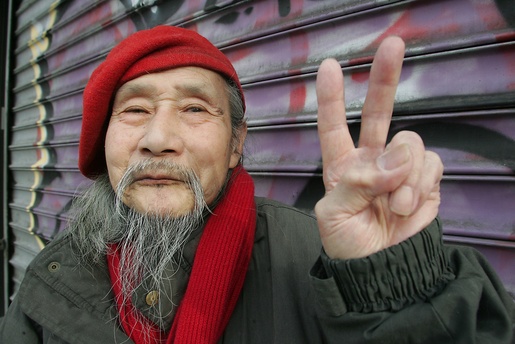

"Living Treasures" of New York - Jimmy Mirikitani (1920-2012)
 APA_Institute
APA_Institute
|

|
||
| Licensing | ||
Jimmy Tsutomu Mirikitani
Photo by Hiroko Masuike
(b. June 15, 1920, Sacramento, CA; d. October 21, 2012, New York, NY)
Jimmy Tsutomu Mirikitani was born in Sacramento, California, in 1920 and raised in Hiroshima, Japan. At age 18, he returned to the United States to pursue a career in art and escape the growing militarism in Japan. He was living with his sister Kazuko and her family in Seattle, Washington, when the Japanese attacked Pearl Harbor in 1941. Executive Order 9066 forced Jimmy and his sister to leave their home and move to separate internment camps hundreds of miles apart. Kazuko was sent to the Minidoka camp in Idaho while Jimmy was sent to Tule Lake, in northern California.
When the government required internees to take a loyalty test, Tule Lake became a segregation center where those deemed "disloyal" were congregated. Thousands there renounced their US citizenship in protest. Jimmy was one of these renunciants. After the war ended, Jimmy and hundreds of others continued to be held without charge, first in Tule Lake, then in a Department of Justice INS camp in Crystal City, Texas. A single lawyer, Wayne Collins, worked for decades to help Jimmy and 5,000 other renunciants reclaim the citizenship they had given up under duress.
In 1946, Jimmy was transferred to Seabrook Farms, a frozen food manufacturing plant near Bridgeton, New Jersey. Here, he and other renunciants on "relaxed internment" worked the 12 hour night shift, six days a week, sorting vegetables on an assembly line. By August 1947, Collins won their release, but fully restoring their citizenship took another decade.
Jimmy finally arrived in New York City in the early 1950's to attempt to resume his art career. When an art professor found him sleeping in Columbia University's library, Jimmy was referred to the New York Buddhist Church where he was provided with room, board, and training as a cook. For years he traveled the East Coast to do seasonal work in resorts, summer camps, and country clubs. While cooking at a restaurant on Long Island, he met Jackson Pollock.
Jimmy's US citizenship was finally restored in 1959, but by then he had moved so often that the government's letter never reached him. Eventually Jimmy became a live-in cook on Park Avenue. But when his employer died in the late 1980's, Jimmy was suddenly again without a home or a job. Within a year, he was living in Washington Square Park in Greenwich Village, selling his artwork to survive. He met Linda Hattendorf in Soho in 2001. She helped him apply for Social Security, SSI, and housing benefits, and in 2002 he moved into an assisted-living retirement center run by Village Care of New York, where he lived until his passing in October of 2012.
All Rights Reserved.
For more information about the artist, his work, or the award-winning film, “The Cats of Mirikitani,” by Linda Hattendorf and Masa Yoshikawa, please visit www.thecatsofmirikitani.com
For information about the Jimmy Mirikitani traveling exhibit available through the Wing Luke Asian Museum, please visit http://www.wingluke.org/exhibitions/mirikitani.html
Based on this original

|
Peace 2003 |
 "Living Treasures" of New York - Eugenia Sumiye Okoshi (1921-2008)
"Living Treasures" of New York - Eugenia Sumiye Okoshi (1921-2008) "Living Treasures" of New York - Jimmy Mirikitani (1920-2012)
"Living Treasures" of New York - Jimmy Mirikitani (1920-2012) "Living Treasures" of New York - Frank Taira (1913-2010)
"Living Treasures" of New York - Frank Taira (1913-2010)
 Journal feed
Journal feed
